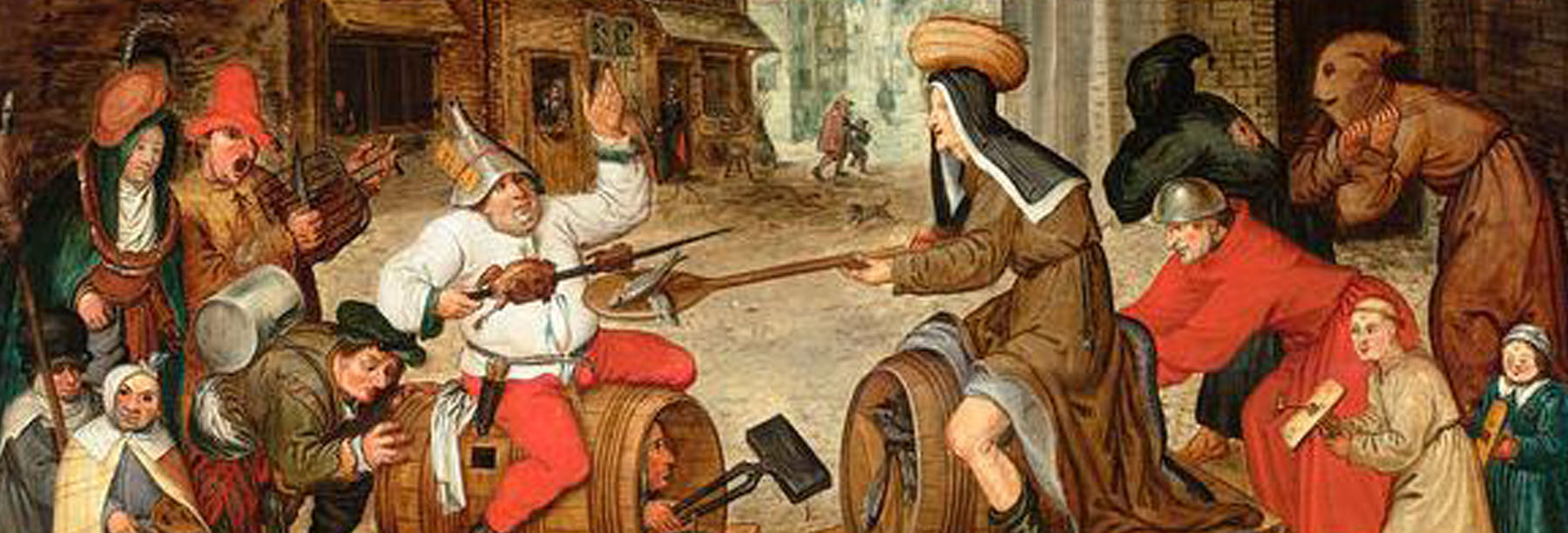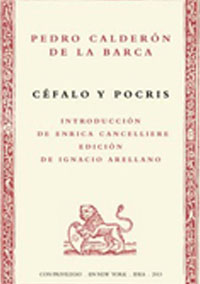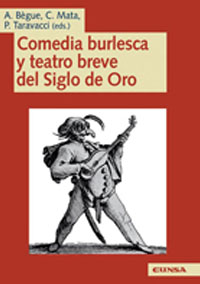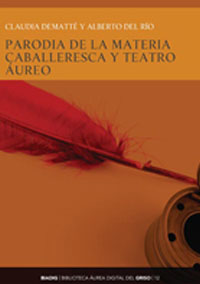Burlesque comedies
One of the projects of research of the GRISO consists of publishing the complete corpus of the burlesque comedies of the Golden Age. To date, we already have more than thirty modern editions of the fifty or so plays that have been preserved.
These parodic plays, constructed with the carnivalesque techniques of the "world turned upside down" and a fully grotesque aesthetic, are the ridiculous underside of the serious drama of the Golden Age. They are very entertaining plays, still capable of arousing the laughter of the contemporary reader or spectator.
The burlesque comedies of the Golden Age, also known at the time as comedias de disparates, en chanza or de chistes, are parodic plays that were performed at Carnival (and also at St. John's Day) as part of courtly festivities held at the Palace or at the Buen Retiro, although we have no record of them ever being performed in the corral. These two characteristics(carnivalesque theatre and courtly theatre) are the essential keys to the study of these plays. Their primary function was to make the courtly spectator (the king and his nobles) laugh , and to this end the authors used all the resources at their disposal, on the double plane of scenic and verbal comedy. These pieces of nonsensical jocularity show on the stage a carnivalesque "upside-down world" where absolutely everything (characters, themes, literary motifs and dramatic conventions...) is grotesquely parodied, brutally degraded, subjected to intense processes of comic abrasion.
Burlesque comedies reached their peak of splendour during the reign of Philip IV. One of the first we know of, although its text and even its degree scroll have been lost, was written by Hurtado de Mendoza, Quevedo and Mateo Alemán and performed in July 1625 by the king's valets. We know that Los siete infantes de Lara, by Cáncer and Juan Vélez, was performed in 1650; El caballero de Olmedo, by Monteser, in 1651 La renegada de Valladolid, by Monteser, Solís and Silva, in 1655; in 1660, apparently, Céfalo y Pocris, by Calderón; in 1671, Blas, by an unknown author and lost; in 1673, El hidalgo de la Mancha, by Matos Fragoso, Diamante and Juan Vélez; in 1685, Las bodas de Orlando; in 1686, El rey don Alfonso, el de la mano horadada (King Don Alfonso, he of the pierced hand), etc. On the other hand, several of them(El rey Perico y la dama tuerta, by Diego Velázquez del Puerco, the anonymous Angélica y Medoro and Don Quijote de la Mancha resucitado en Italia or two pieces by Félix Moreno y Posvonel, El muerto resucitado and Pagarse en la misma flor and Boda entre dos maridos) are quite late: They belong to the 18th century, a circumstance that tells us about the success achieved by this peculiar dramatic sub-genre, the antithesis of tragedy and serious dramas.
Its cultivation must be related to the boom in other forms of "laughter-provoking" literature (burlesque romances, jocular dialogues, entremeses, mojigangas, vejámenes, pullas, fiestas de locos...) from the beginning of the 17th century. Serralta linked the origin of burlesque comedies to the coplas de disparates. Today, critics point to their relationship with the entremés, and in particular with the burlesque entremés (the Entremés de los romances, that of La Infanta Palancona or that of Melisendra can be considered miniature burlesque comedies). Works such as Guillén de Castro's Don Quijote de la Mancha or Lope's El príncipe melancólicocould also be considered precursors of the genre. Finally, we should also consider the possible character of some of them as "sudden" works. Degree There are very elaborate burlesque comedies, which present a high degree of complexity and which cannot be the result of improvisation techniques(Céfalo y Pocris or Darlo todo y no dar nada), but there are others such as Escarramán or La creación del mundo, by Luis Vélez y Calderón, which has not been preserved. Some burlesque comedies were integrated into fictitious academies, as is the case with El hermano de su hermana (his sister's brother) (included in the Obras de Quirós).
As for the authorship of these plays, several of the surviving ones are anonymous, and partnership is often found between two or three authors. In general, their authors are not leading playwrights (with the exception of Calderón, author of Céfalo y Pocris). Cáncer was one of the most assiduous in the genre, as was Vicente Suárez de Deza. Other authors include Juan Vélez de Guevara, Francisco Antonio de Monteser, Francisco Bernardo de Quirós, Pedro Lanini Sagredo, etc.
position Traditionally neglected by critics until the end of the 1970s, these works began to receive more attention in the 1980s (with works by Arellano, Borrego, Casado, Di Pinto, García Lorenzo, García Valdés, Holgueras, Huerta Calvo, Mata Induráin, Morell, Rodríguez Rípodas and Serralta, among others). Since then, interesting theoretical programs of study and analyses of specific works have been prepared, as well as modern editions of burlesque comedies (critical editions, with well-arranged texts, preliminary programs of study and the appropriate annotation, especially necessary in this genre due to the abundance of jokes, malicious allusions, double entendres, puns, etc.).
As far as the GRISO work is concerned, seven single titles were published by Espasa Calpe, Edition Reichenberger and Eunsa:
|
► Cephalus and Pocris. ► Give everything and give nothing. ► The Knight of Olmedo. ► El comendador de Ocaña. |
► El Hamete de Toledo. ► His sister's brother. ► Bliss in misfortune and country life. |
But the complete corpus is being published in the collection "Library Services Áurea Hispánica" of the publishing house Iberoamericana / Vervuert, where seven volumes have already appeared containing these twenty-five titles:
|
► Love, wit and woman. ► Angelica and Medoro. ► Antiochus and Seleucus.Punish for defending. ► Give everything and give nothing. ► The truest love, Durandarte and Belerma. ► Punishment in arrogance. ► The siege of Tagarete. ► Disdain, with disdain. ► The marshal of Virón. ► The dead man risen. ► The beauty award . ► The virtue award . |
► King Alfonso, the one with the pierced hand. ► King Perico and the one-eyed lady. ► Elena's theft. ► Scanderbey. ► La renegada de Valladolid. ► The coming of the Duke of Guisa and his armada to Castelamar. ► Venture without seeking it. ► Las mocedades del Cid. ► The lovers of Teruel. ► The Counts of Carrión. ► There is no life like honor. ► Danger in remedies. |
The names of all those researchers who have edited or are editing any of the burlesque comedies are included, as well as those of others who have studied them at framework of the GRISO's project :
|
► Ignacio Arellano ► Esther Borrego ► Carlos F. Cabanillas árdenas ► Enrica Cancelliere ► María José Casado Santos ► A delaida Cortijo Ocaña ► A ntonio Cortijo Ocaña ► Daniele Crivellari ► A lberto del Río Nogueras ► Claudia Demattè ► Elena Di Pinto ► Juan Manuel Escudero ► Francisco J. García Cabrera ► Celsa Carmen García Valdés |
► Milena M. Hurtado ► Emmanuel Marigno ► Carlos Mata Induráin ► Valentina Nider ► Maite Pascual Bonis ► B lanca Periñán ► Daniela Pierucci ► M. Carmen Pinillos ► Maria Grazia Profeti Alberto Rodríguez Rípodas ► Carola Sbriziolo ► Frédéric Serralta ► Pietro Taravacci ► Marcella Trambaioli |
The criteria for the project edition of the Golden Age burlesque comedies are those applied by the GRISO and are listed in several places:
► I. Arellano and J. Cañedo, "Observaciones provisionales sobre la edición y anotación de textos del Siglo de Oro", in Edición y anotación de textos del Siglo de Oro, Pamplona, Eunsa, 1987, pp. 339-355.
► I. Arellano, "Edición crítica y anotación filológica en textos del Siglo de Oro. Notas muy sueltas", in Crítica textual y anotación filológica en obras del Siglo de Oro, Madrid, Castalia, 1991, pp. 563-587.
► I. Arellano and Á. Cilveti, prologue to the critical edition of P. Calderón de la Barca, El divino Jasón, Pamplona / Kassel, Universidad de Navarra / Edition Reichenberger, 1992, where the graphic modernization or dispositio of the texts is justified at greater length.
► I. Arellano, Editar a Calderón, Madrid / Frankfurt am Main, Iberoamericana / Vervuert, 2007.
|
Preliminary phase (1987-1994) |
In a preliminary stage (1987-1994), several GRISO researchers had edited some loose burlesque comedies: ► Quirós, F. B. de, El cerco de Tagarete, ed. C. C. García Valdés, Criticón, 37, 1987, pp. 77-115. ► Monteser, F. A. de, El caballero de Olmedo, in C. C. García Valdés, De la tragicomedia a la comedia burlesca: "El caballero de Olmedo", Pamplona, Eunsa, 1991, pp. 183-262. ► A nonymous, La ventura sin buscarla. Comedia burlesca parodia de Lope de Vega, ed. del GRISO directed by I. Arellano, Pamplona, Eunsa, 1994. |
|
development (years 1998-2011) |
Subsequently, the GRISO considered the possibility of publishing the complete corpus of these plays, which would be included in a series entitled Comedias burlescas del Siglo de Oro, which since 1998 has been published in the collection "Library Services Áurea Hispánica" of the publishing house Iberoamericana / Vervuert, where seven volumes have been published: ► Comedias burlescas del Siglo de Oro, volume I, Anonymous, El rey don Alfonso, el de la mano horadada, ed. C. Mata, Madrid / Frankfurt am Main, Iberoamericana / Vervuert, 1998. Comedias burlescas del Siglo de Oro, vol. II, ed. del GRISO directed by I. Arellano, Madrid / Frankfurt am Main, Iberoamericana / Vervuert, 2001. Includes Los amantes de Teruel ( ed. E. Borrego), Amor, ingenio y mujer (ed. E. Borrego), La ventura sin buscarla ( ed. I. Arellano) and Angélica y Medoro (ed. I. Arellano and C. Mata). ► Comedias burlescas del Siglo de Oro, vol. III, ed. del GRISO directed by I. Arellano, Madrid / Frankfurt am Main, Iberoamericana / Vervuert, 2002. Includes El cerco de Tagarete ( ed. J. M. Escudero and C. C. García Valdés), El amor más verdadero, Durandarte y Belerma (ed. A. and A. Cortijo), La renegada de Valladolid(ed. F. Serralta) and Castigar por defender ( ed. A. Rodríguez Rípodas). Comedias burlescas del Siglo de Oro, vol. IV, ed. A. Rodríguez, Madrid / Frankfurt am Main, Iberoamericana / Vervuert, 2003. Includes: Las mocedades del Cid, El castigo en la arrogancia, El desdén, con el desdén and El award de la hermosura. Comedias burlescas del Siglo de Oro, vol. V, ed. del GRISO directed by I. Arellano, Madrid / Frankfurt am Main, Iberoamericana / Vervuert, 2004. Includes: Los condes de Carrión ( ed. C. F. Cabanillas Cárdenas), Peligrar en los remedios(ed. E. Borrego), Darlo todo y no dar nada ( ed. I. Arellano) and El award de la virtud ( ed. E. Di Pinto). Comedias burlescas del Siglo de Oro, vol. VI, ed. del GRISO directed by I. Arellano, Madrid / Frankfurt am Main, Iberoamericana / Vervuert, 2007. Includes: El rey Perico y la dama tuerta ( ed. M.ª J. Casado), Escanderbey (ed. M.ª J. Casado), Antíoco y Seleuco (ed. M.ª J. Casado) and La venida del duque de Guisa y su armada a Castelamar ( ed. B. Periñán y D. Pierucci). ► Comedias burlescas del Siglo de Oro, vol. VII, ed. del GRISO, Issue directed by C. Mata, Madrid / Frankfurt am Main, Iberoamericana / Vervuert, 2011. Includes: El mariscal de Virón ( ed. M. M. Hurtado and C. Mata Induráin), No hay vida como la honra ( ed. C. Sbriziolo), El robo de Elena ( ed. F. J. García Cabrera and C. Mata Induráin) and El muerto resucitado ( ed. M.ª J. Casado Santos). |
|
Final phase |
It is planned to continue publishing the other titles of the burlesque comedies of the Golden Age, until fill in the edition of the corpus. The titles currently in preparation are the following: ► Cephalus and Pocris, ed. I. Arellano. ► Durandarte and Belerma (uncensored version), ed. V. Nider. ► El más impropio verdugo, ed. E. Di Pinto. ► La más constante mujer, ed. A. Rodríguez Rípodas. ► La mayor hazaña de Carlos VI, ed. C. Mata Induráin. ► La muerte de Baldovinos ( two versions), ed. C. C. García Valdés. Llámenla como quisieren, ed. C. Mata Induráin. ► Los siete infantes de Lara, ed. C. Mata Induráin. ► Paying each other in the same flower and Wedding between two husbands, ed. P. Taravaci. There are also plans to publish other volumes including the complete surviving burlesque festejos (Las bodas de Orlando, No hay vida como la honra...) as well as the short pieces (loas, mojigangas, entremeses, etc.) for burlesque comedies. |
|
|
Anonymous, Cada cual con su cada cualMarcella Trambaioli, Pamplona, Publishing Services of the University of Navarra, 2014 (Library Services Áurea Digital, BIADIG, 25 This Issue offers the critical edition of the anonymous burlesque comedy Cada cual con su cada cual, whose degree scroll, which is a proverbial phrase, announces the eventful weddings of the two infantas of a grotesque and provincial court with their worthy suitors: the Prince and Escalante. In fact, it is a comedy of absurdities that does not parody any specific play. Several textual indications refer to a late composition, so its peculiarities shed light on the last phase of development of the theatrical typology to which it belongs. The annotation attempts to elucidate anachronistic linguistic usages, burlesque devices, cultural and stylistic elements, in addition to mentioning parallel passages from other comedies and contemporary literary texts. |
|
|
Pedro Calderón de la Barca, Cephalus and Pocris, introduction by Enrica Cancelliere, edited by Ignacio Arellano, New York, IDEA, 2013. The universal genius of Calderón de la Barca was not only interested in the field of tragedy or the fables of great spectacle and the auto sacramental. Although less studied, his comic work is no less important. Among all his comedies of humour, the burlesque and nonsensical Céfalo y Pocris stands out, an astonishing grotesque parody that constitutes a veritable encyclopaedia of the aurisecular mechanisms of laughter and an unsurpassable example of Calderón's wit. This edition has been prepared by Ignacio Arellano. The introduction, which outlines the main lines of the comedy, is by Enrica Cancelliere, who offers in her study the fundamental keys to the reading of Céfalo y Pocris, surely the best comedy of its genre. |
|
|
Recently published the Issue graduate Comedia burlesca y teatro breve del Siglo de Oro, ed. A. Bègue, C. Mata Induráin and P. Taravacci, Pamplona, Eunsa, 2013 (col. "Publicaciones de Literatura-department de Philology", ISBN: 978-84-313-2922-8). This book brings together fifteen contributions from two different - though sometimes related - areas of Golden Age drama: burlesque comedy and short plays. The works related to the short theatre include approaches to a particular loa and its palatial recasting at the end of the 17th century, to the Entremés de los rufianes by González de Eslava, to the entremeses inserted in some comedias lopescas and to the jácaras by Quevedo, or they analyse the theatrical controversy towards the end of the 18th century, the costume of the figurehead in entremeses and comedias or the motif of the check defending his daifa. The eight contributions on burlesque comedy examine questions such as its staging, the metatheatrical play present in these plays, their critical scope, the relationship between burlesque entremés and burlesque comedy, the parodic rewriting of serious models, plus burlesque self-rewriting and versification, or focus attention on a specific play such as Cada cual con su cada cual. TABLE OF CONTENTS:► A lain Bègue, "From Cadiz to the court: a particular loa and its palatial recasting in the late seventeenth century." ► María José Casado Santos, "La comedia burlesca y su puesta en escena". ► Daniele Crivellari, "Entre versos anda el juego: autorreescritura burlesca y versificación." ► A lberto del Río Nogueras, "La parodia de la subject caballeresca en ámbito cortesano (a purpose de Feliciano de Silva, la comedia Las aventuras de Grecia y su model serio, el Don Florisel de Niquea de Montalbán)." ► Claudia Demattè, "Fame in parody: Juan Pérez de Montalbán and his burlesque rewriters." ► Judith Farré Vidal, "La indumentaria del figurón en entremeses y comedias." ► A rnulfo Herrera, "El Entremés de los rufianes y una coincidencia histórica." ► Carine Herzig, "Short drama and ethical controversy in late 17th century Spain: fact vs fiction." ► María Luisa Lobato, "El motivo del jaque defensor de su daifa en la primera generación de poetas." ► Emmanuel Marigno, "Ridiculous figures and alteration of power in Quevedo's jácaras: links and denouements with burlesque comedy." ► Valentina Nider, "The Infanta Palancona(ante 1616) and the burlesque comedy." ► Maria Grazia Profeti, "The double face of "burlesque" comedy." ► Frédéric Serralta, "Around some entremeses inserted in three comedies by Lope(El mayordomo de la duquesa de Amalfi, La villana de Getafe and El tirano castigado)." ► Pietro Taravacci, "Space, time and report in the metatheatrical play of burlesque comedy." ► Marcella Trambaioli, "The nonsensical court of Cada cual con su cada cual, late Baroque burlesque comedy." |
|
|
Edition of "Las aventuras de Grecia" and its serious model , Montalbán's "Don Florisel de Niquea" (2012) In 2012, the "GRISO Digital Publications" collection welcomed the publication of Claudia Demattè and Alberto del Río's book graduate Parody of the chivalrous subject and golden theater. Edition of "Las aventuras de Grecia" and its serious model , the "Don Florisel de Niquea" by Montalbán., Pamplona, Publishing Services of the University of Navarra, 2012 (ISBN: 978-84-8081-336-5). The Issue includes the annotated edition of the burlesque comedy Las aventuras de Grecia, which thus adds to the titles already published within the project edition of the complete corpus. The burlesque comedy is published together with its serious model , Don Florisel de Niquea by Juan Pérez de Montalbán, which is presented in an edition without notes, since its role here is to support the reading of the parodied piece. |





